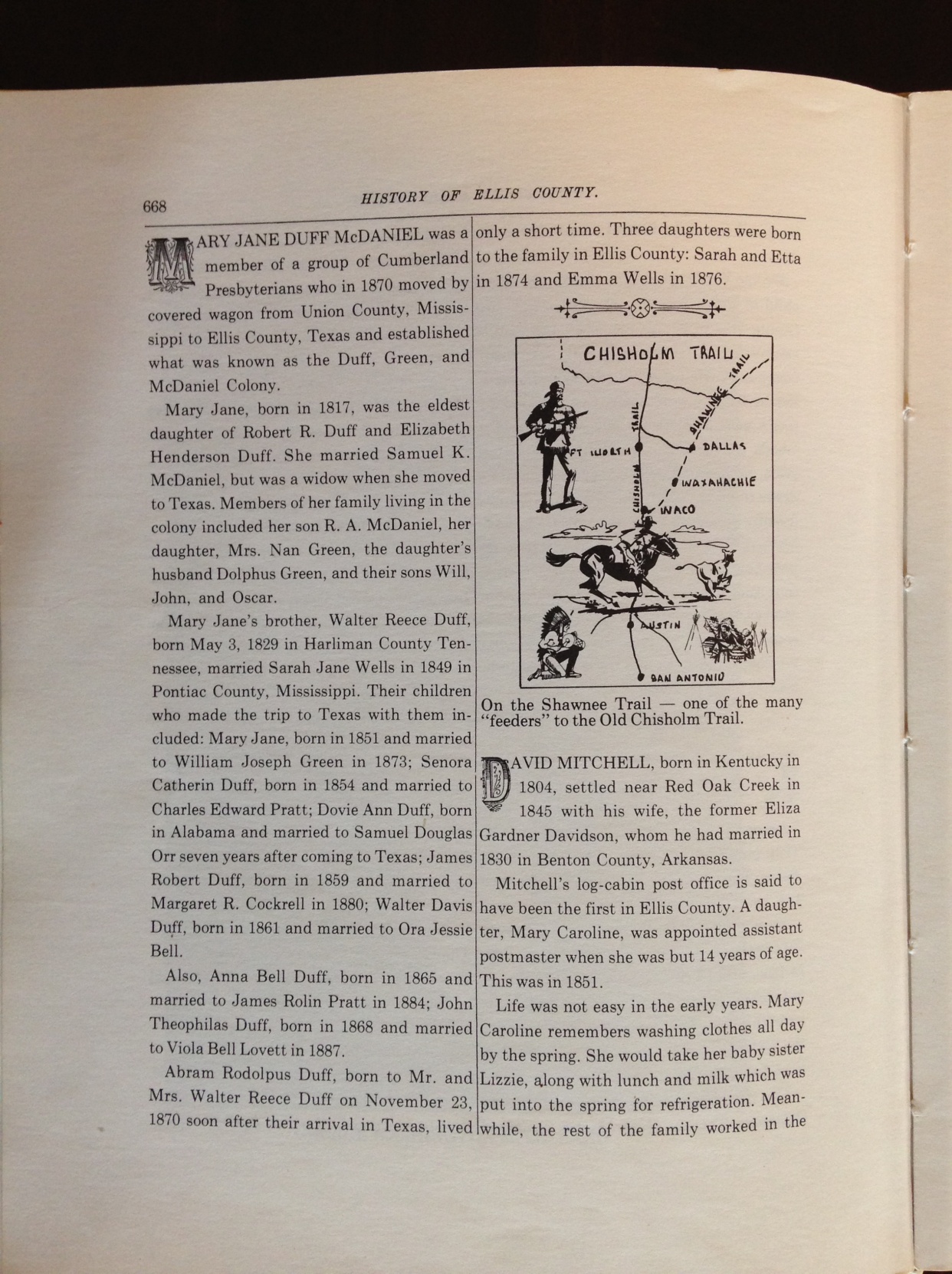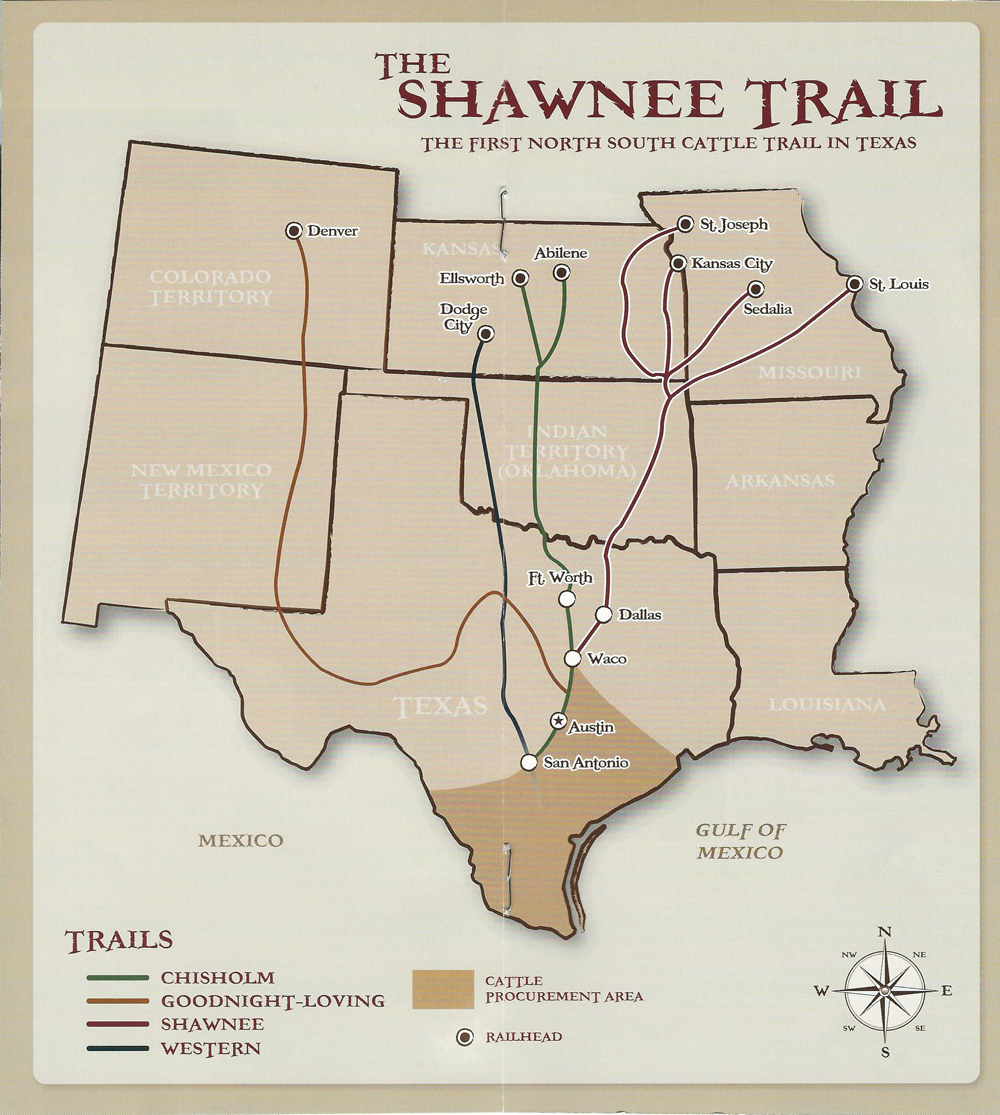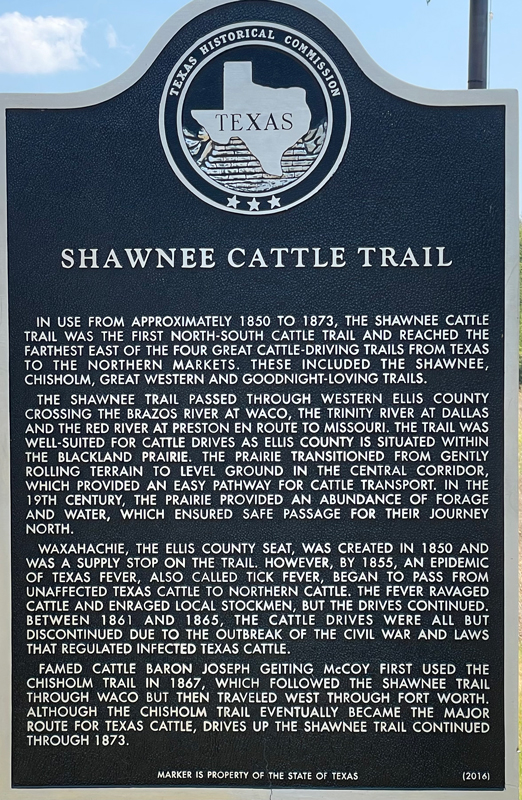I. CONTEXT
In the latter part of the 19th century, the Shawnee Trail was the first north-south cattle trail and the farthest east of the four great cattle-driving trails from Texas to northern markets, the others being the Chisholm, the Great Western, and the Goodnight-Loving trails. Spanning a period roughly between 1850-1873, the Shawnee Trail provided a means for ranchers and drovers to move thousands of head of Texas longhorns from south Texas north to Missouri railheads in St. Louis, Baxter Springs, and Sedalia.1
Although some longhorns were being driven north in the 1840s, cattle drives became larger in 1849 and 1850. The Dallas Herald reported in the summer of 1850 that “[s]everal large droves of cattle have passed through this place during the present season en route to Missouri. They are brought mostly from the upper Brazos and carried to Missouri, to be sold for beef, or to furnish teams for California emigrants.”2
II. OVERVIEW
By virtue of its north by northeast pathway, the Shawnee Trail passed through the western portion of Ellis County on its route to Missouri crossing the Brazos River at Waco, then the Trinity River at Dallas, and on to the Red River crossing at Preston. The trail followed a natural route well suited to driving cattle. Ellis County, along with other counties on a swath from below San Antonio to the Red River, lies within the Blackland Prairie, one of ten ecoregions in the state of Texas. Situated between the Cross Timbers to the west and the Post Oak Savannah and Piney Woods to the east, the hills and forests that flank the Blackland Prairie region made trailing cattle through the areas difficult, while the Blackland Prairie is gently rolling to level, making the central corridor an easier transportation pathway to trail cattle.3 In addition, the land cover of the region during the 19th century was predominantly tallgrass prairie, providing ample forage for cattle on the long journey north.4 The final component needed was plenty of water.
Ellis County is criss-crossed by several creeks, and shallow natural springs dot the western portion of the county. Early pioneers to the county also settled near these watering holes. Benjamin Franklin Hawkins (January 18, 1828-April 23, 1891) moved with his family from Indiana to the area in 1848 and settled near the head of Waxahachie Creek near present-day Midlothian on what was known as Hawkins Springs. Ellis County, not organized until 1849, was still a part of Navarro County, and “there was only a trailway leading at that time from Dallas to Austin.”5 In addition, John Hawkins Singleton (June 25, 1818-August 3, 1884) moved to Texas in 1848 and settled at Mammoth Springs, just a short distance south of Mountain Peak northwest of Waxahachie and south of Midlothian,6 and to the south, Archibald Greathouse (1805-1855) settled on one of the tributaries of Chambers Creek, now known as Greathouse Branch, in the same year.7
In 1851, Nicholas P. Sims (August 15, 1806-May 24, 1902) and his siblings John Dabney Sims (1802-April 1878), Mariah B. Sims (1809-September 17, 1882), and Lucy P. Sims Brack (March 13, 1814-March 13, 1886) with husband Ezekial Marshall Brack (January 13, 1815-November 1, 1888) migrated to Ellis County from Mississippi settling along an extended stretch of Chambers Creek.8 Brack and his relatives settled just south of Greathouse on Machete Spring, later called Brack Springs, near what became the Boz-Bethel area in southwest Ellis County. Nicholas P. Sims soon moved farther south on Chambers Creek and purchased acreage that was to become the foundation for the L.R. Campbell Ranch, later known as the Pecan Springs Ranch.
In 1852, Sims donated ten acres of land to the Bethel Methodist Church, first established at High Springs. The newly formed county was sparsely populated and the area around present day Pecan Springs Ranch along Chambers Creek was a wide open space thick with prairie grass and a plentiful supply of water. Local historian Jean Caddel (October 15, 1925-August 22, 2008) noted that “all of these springs from High to Hawkins, it appears, were on the Dallas – Waco road and the cattle trail.”9 At that time, according to Brack, “there were no roads in western Ellis County, just a cow trail leading from Greathouse Branch northeast to Waxahachie by way of Buena Vista.”10
Cattle trails were unlike narrow, well-defined roads or highways, “but instead were broad swaths of territory that were anywhere from 100 yards to perhaps half mile wide, and that in certain places (just south of river crossings, for example), herds could spread out for a mile or more in order to either bed down or seek a viable crossing site.”11 Texas rancher and western author Tom B. Saunders, IV, states:
Only rarely did any herd follow directly in the footsteps of another, because the grass was eaten by whatever herd arrived first. They would follow the same general direction when their destinations were the same or because of good water or abundant feed, or to travel easier terrain. The only time one rancher’s cattle would trace the exact trail of any earlier bunch was through a pass in the hills, or over a shallow ford in a river, or near a town for supplies. Otherwise they would cut trails to one side or the other of a previous bunch in order to find the best grazing lands.12
Seeking water and forage, herds on the Shawnee Trail most likely spread out over this wide north-south pathway on the western side of Ellis County on its road north, perhaps stopping for supplies in the newly created county seat of Waxahachie founded in 1850. But by 1855, trouble had already started to plague drovers on the Shawnee Trail. An epidemic of Texas fever, also called tick fever, carried to the north by unaffected Texas longhorns had begun to ravage northern cattle, killing many animals and enraging local stockmen. Despite the threats from Missouri ranchers, the cattle drives continued.13
Mormon leader Homer Duncan (January 19, 1815-March 23, 1906), leading a group of 42 people and 1,300 head of cattle “assembled in Ellis County…and trailed the herd northward up the old Shawnee Trail across the Red River at Preston” in May 1857.14 On May 18, 1859, the Dallas Herald reported: “Yesterday a drove of two thousand beef cattle passed through Dallas en route to the North,”15 and three weeks later on June 8, the same paper noted: “The great exodus of cattle northward for this season seems to have ceased.”16
Indeed the cattle drives all but discontinued between 1861-1865. New laws regulating infected Texas cattle driven to Missouri and the outbreak of the Civil War called a halt to the Shawnee Trail until 1866 when cattle drives started up again in full force.17 Well-known cattle baron Joseph Geiting McCoy (December 21, 1837-October 19, 1915) noted in 1866: “We have heard the number of cattle that had crossed Red River…put down as high as 260,000 head.”18 However, Kansas and Missouri blockades caused McCoy to seek out other markets farther west in Abilene in 1867, thus starting the Chisholm Trail which branched off the Shawnee Trail at Waco and traveled west through Fort Worth.19
Even though the Chisholm Trail then became the major route for Texas cattle traveling to northern markets, drives up the Shawnee Trail lasted until 1873. Cattleman George Washington Saunders (February 12, 1854-July 3, 1933) gathered the stories of old drovers who trailed cattle in Texas and several mentioned their experiences on the Shawnee Trail, either specifically or by inference to their route through Ellis County.
Rev. William Henry Farmer (April 10, 1819-December 22, 1906) “traded his holdings for beef cattle…and started up the trail in March, 1866. [They] traveled the lower trail, passing through Austin, Waco, Dallas and Sherman.”20 As a young drover in March 1868, Joseph Cotulla (March 19, 1844-August 17, 1923) “went to Nueces and drove a herd from the Altito to Abilene, Kansas, for L.B. [Leasial B.] Harris (February 18, 1827-February 6, 1908). [They] crossed these cattle below San Juan mission, going by way of Austin, Waco and Dallas.”21
Alexander David McGehee (October 17, 1857-December 4, 1930) first went up the Western Shawnee Trail at eleven years old with his brother George Thomas McGehee (February 6, 1836-September 13, 1926) in 1868. They “drove from Belton to Abilene, Kansas. The trail then went by the village of Dallas, [and] crossed the Red River at Colbert’s Ferry, near where Denison is now located.”22 In April of 1869, drover George Henry Mohle (November 29, 1847-October 11, 1918) was employed by rancher John William “Black Bill” Montgomery (December 10, 1842-October 11, 1895) to trail a herd of 4,500 head of cattle to Abilene Kansas. They “started from Lockhart and crossed the Colorado River below Austin, out by way of Georgetown, Waxahachie and on to Red River, which [they] found very high.”23
Men were not the only ones to experience a cattle drive on the Shawnee Trail. In April 1871, Mrs. Amanda Burks (February 8, 1841-September 15, 1931) accompanied her husband William Frank Burks (June 11, 1839-January 27, 1877) on a drive “during the days that Texas cattle could be marketed only by driving them over the old Kansas Trail.”24 Riding in a buggy alongside her husband for the three-month journey, she recalled the drive through Ellis County:
There were few people living along the trail, but when going through Ellis County we saw an old woman sitting in the doorway of a small house stringing beans. We remarked to her that we saw very few women in that part of the country. She answered, “Yes, sir, I’m the first woman that made a track in Dallas County, and I would be back in Tennessee now, only I would have to go through Arkansas to get there. I guess I’ll stay right here.”25
By the early 1870s, the more popular Chisholm Trail was carrying the bulk of Texas longhorns to northern markets. In January of 1870, The Emporia [Kansas] News reported that only “50,000 cattle came over the Shawnee Trail last year.”26 By 1873, the end had come for the Shawnee Trail.27
III. SIGNIFICANCE
Although the short-lived Texas cattle trails forever sealed the public’s image of the American cowboy and western culture, the Shawnee Trail in particular served a more significant purpose as only one facet of an historic transportation corridor through Ellis County. Following a previously used Indian trail, Col. William Gordon Cooke (March 26, 1808-December 24, 1847) led an expedition in 1840-41 to cut a military road between Austin and the Red River through the central part of the new Republic, passing through what became Ellis County. 28 In 1842, William Ross Howe (?-1847) was the first white settler to build a house in the area on the north side of Chambers Creek bordering Cooke’s military road. His home was the first stage and mail coach stop for North Central Texas by authority of the Republic.29 Howe’s original survey is situated in close proximity to today’s Pecan Springs Ranch.
Howe was only one of a long line of emigrants from the Midwest to make their way to Texas. Thousands travelled south on what was called the Texas Road in the mid 1800s. This corridor from the Red River through Dallas, Waco, and Austin was the same route followed northbound by drovers on the Shawnee Trail.30 After Ellis County was formed from Navarro County in December of 1849, the first commissioners began planning county roads. One of the first proposed in October of 1852 near the cattle trail was a “road leading from the town of Waxahachie in the direction of the town of Waco…crossing Chambers Creek at or near Sims Camp Ground,”31 which would have been the original settling location of the extended Sims family when they relocated to Ellis County.
By the onset of the Civil War, there were thirty-one stage lines operating in Texas, and two of them ran through Ellis County. The route on the western side of the county also closely followed the Shawnee Trail from Waco through Waxahachie and Dallas.32 When the Missouri, Kansas & Texas Railroad (MK&T) entered Ellis County in 1890, it too roughly followed the old military road and cattle trail through Milford and Italy “northward to Chambers Creek and Ellis County’s oldest community (Howe’s Settlement)…renamed Forreston”33 to Red Oak before entering Dallas County.
Progress continued when an expanded interurban line from Dallas to Waco paralleled the MK&T railroad track in 1913 running from Milford through Italy, Forreston, Waxahachie, Sterrett, and Red Oak.34 The 1920s saw the construction of State Highway 6 (the present U.S. Highway 77) from Forreston to Sterrett,35 with the route extended to include a stretch between Dallas and Waco in 1932.36 In addition, the construction of Interstate 35 East in the 1950s and 1960s brought the national highway through Ellis County by way of Milford, Italy, Forreston, Waxahachie, Sterrett, and Red Oak.37
This historic and significant thoroughfare, once occupied by the Shawnee Trail which saw thousands of head of Texas longhorns course their way through Ellis County on the first of the major cattle trails of the Old West, has done much over the last 175 years to enhance the progress and prosperity of Ellis County.
Many thanks to Ms. Sharan Farmer, B.A., for her historical research contributions about Pecan Springs Ranch and Ellis County. Ms. Farmer submitted the narrative for The Shawnee Cattle Trail to the Ellis County Historical Commission and the Texas Historical Commission.
IV. DOCUMENTATION
1 Gard, Wayne. “The Shawnee Trail.” The Southwestern Historical Quarterly, January, 1953. Texas State Historical Association. The Portal to Texas History. Web. 8 July 2015. pp. 359-360.
2 Texas State Gazette. (Austin, Tex.), Vol. 1, No. 46, Ed. 1, Saturday, July 6, 1850. Austin, Texas. The Portal to Texas History. Web. 8 July 2015.
3 “Texas Ecoregions.” Texas Parks & Wildlife Department. N.p., n.d. Web. 7 Aug. 2015.
4 Auch, Roger F. “Texas Blackland Prairies Ecoregion Summary.” Land Cover Trends. U.S. Geological Survey, 28 July 2014. Web. 7 Aug. 2015.
5 Memorial and biographical history of Ellis county, Texas ... Containing a history of this important section of the great state of Texas, from the earliest period of its occupancy to the present time, together with glimpses of its future prospects; with full-page portraits of the presidents of the United States, and also full-page portraits of some of the most eminent men of the county, and biographical mention of many of its pioneers, and also of prominent citizens of to-day. Chicago: Lewis Publishing, 1892. Print. p. 11.
6 “Mountain Peak.” USGenWeb Project hosted by Rootsweb. 2002. Web. 10 Aug. 2015.
7 Caddel, Jean. “The Historic Springs of Ellis County.” Ellis County TXGenWeb, part of USGenWeb Project hosted by Rootsweb. 2001. Web. 7 July 2015.
8Farmer, Michal Martin. “William Sims born, say, 1655, will made 18 December 1710, James City County, Virginia and his Descendants.” Michal M. Farmer, 2011. Web. p. 90. 24 Aug. 2015.
9 Caddel. “The Historic Springs of Ellis County.”
10 Caddel, Jean. “Texas Cattle Trails.” Ellis County TXGenWeb, part of USGenWeb Project hosted by Rootsweb. N.d. Web. 10 July 2015.
11 Norris, Frank. “Cattle Trails—Statement of Significance” (Preliminary Working Draft). N.p., 20 March 2012. Web. 9 July 2015.
12 Saunders, Tom B., IV. The Texas Cowboys: Cowboys of the Lone Star State. Ketchum ID: Stoecklein, 1997. Print. p. 25.
13 Gard, Wayne. “The Shawnee Trail.” p. 366.
14 “Homer Duncan Company (1857).” Mormon Pioneer Overland Travel, 1847-1868. The Church of Jesus Christ of Latter-Day Saints, 2015. Web. 14 July 2015.
15 Gard, Wayne. “The Shawnee Trail.” p. 368.
16 Gard, Wayne. “The Shawnee Trail.” p. 368.
17 Gard, Wayne. “The Shawnee Trail.” p. 369.
18 McCoy, Joseph G. Historic Sketches of the Cattle Trade of the West and Southwest. Kansas City: Ramsey, Millett, Hudson, 1874. Web. 8 Aug. 2015. p. 20.
19 Worcester, Donald E. “Chisholm Trail.” Handbook of Texas Online. Texas State Historical Association, 12 June 2010. Web. 18 Aug. 2015.
20 Hunter, J. Marvin, and B. Byron Price, eds. The Trail Drivers of Texas: Interesting Sketches of Early Cowboys and Their Experiences on the Range and on the Trail during the Days That Tried Men's Souls, True Narratives Related by Real Cowpunchers and Men Who Fathered the Cattle Industry in Texas. 1924. Austin: University of Texas Press, 1985. University of Texas Libraries. University of Texas at Austin, 23 Mar. 2011. Web. 4 Aug. 2015. pp. 590-592.
21 Hunter, p. 318.
22 Hunter, p. 489.
23 Hunter, pp. 42-45.
24 Hunter, pp. 295-296.
25 Hunter, p. 299.
26 “Texan Cattle.” The Emporia News. (Emporia, KS.), 28 Jan. 1870. Chronicling America: Historic American Newspapers. Library of Congress. Web. 7 July 2015.
27 Gard, Wayne. “The Shawnee Trail.” p. 376.
28 Britton, Morris L. “Military Road.” Handbook of Texas Online. Texas State Historical Association, 15 June 2010. Web. 12 June 2015.
29 Lavender, James A. The Early Settlement of Ellis County and a Biographical Sketch of the William R. Howe Family. Dallas: n.p., 1941. Granville D. Edwards and Patrick Howe Edwards, 2011. Print. pp. 14-15, 19.
30 Gard, Wayne. The Chisholm Trail. Norman, OK: University of Oklahoma Press, 1979. Web. 18 Aug. 2015. p. 26.
31 Ellis County Commissioners Court Minutes. Vol. A, 1850-1857. County Clerk’s office, Ellis County, Texas. p. 76.
32 “Stage-Routes in Texas.” The Texas Almanac for 1861. n.p.,1860. Texas State Historical Association. The Portal to Texas History. Web. 7 Aug. 2015. p. 225.
33 Ellis County History Overview. Compiled for the U.S. Department of Energy in support of the Superconducting Super Collider Laboratory. Rootsweb, n.d. Web. 7 Aug. 2015.
34 Ellis County History Overview.
35 Ellis County History Overview.
36 “U. S. Highway No. 0077.” Texas Department of Transportation, 2015. Web. 8 Aug. 2015.
37 Ellis County History Overview.
ADDITIONAL SOURCES
The map on this page is the only mention of the Shawnee Trail in published Ellis County history sources other than Jean Caddel’s online county histories previously documented. However, the caption is misleading. The Shawnee Trail was not a feeder trail to the Chisholm Trail, but an independent cattle drive trail in its own right.
Ellis County History: The Basic 1892 Book (with the Presidents Section deleted) with Additional Biographies compiled by the Ellis County Historical Museum and Art Gallery, Inc. Waxahachie, Texas, In Memory of the Courageous Pioneers and Builders of Ellis County. Fort Worth: Historical Publishers, 1972. Print.









